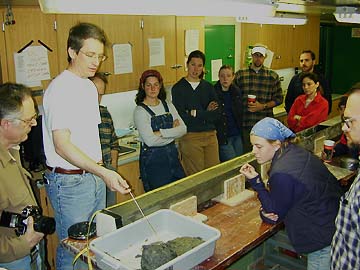
Deep Basin Mapping

Dr. Domack explaining to the assembled science staff the significance of various features in a core collected this morning after 3 attempts to sample the basin floor almost 900 meters below the surface.
The deep basin, which we are working on naming, is producing some very interesting results. In a simplified fashion you can consider that sediments accumulating on the ocean floor are derived from two sources, either the land itself or from biologic processes occurring within the water column itself. In temperate climates like those where most of us live, the land is eroded by mechanical and chemical processes and the sediment is carried by rivers to the sea. When a river flows into the sea its flow rate drops and so does its capacity to carry the suspended sediment. This is why deltas form at the mouths of rivers entering large bodies of water.
In the Antarctic, glaciers are responsible for transporting the materials weathered on land to the ocean. Glacial ice can incorporate sediment ranging in size from very fine to large boulders. Where the glaciers meet the sea a number of things can happen. The ice may break off and float away, or it may melt due to localized warming from the sun. There may even be a melt water stream. All of these methods transfer the sediment from the glacial ice to the ocean. If the sediment is melting out of the ice and being washed into the ocean or being carried by melt water the sediment will precipitate out quickly and sink to the bottom. If it is incorporated into floating ice chunks it may be carried far from shore and be released slowly into the water column as the iceberg melts or deposited locally if the iceberg does not move far from its source.
Sunlight is the driving force of large-scale biologic production in the oceans of the world. Phytoplankton use sunlight and carbon dioxide for photosynthesis and under ideal conditions of temperature, sunlight and nutrients large blooms of Phytoplankton can occur. These blooms are the basis of the food chain in the oceans. Sediments derived from phytoplankton are of similar size, color and composition because the source is constant.
Based on the model outlined above, and analysis of core samples taken in various environments along the Antarctic Peninsula, Dr. Domack and others have developed a model for the kinds of sediments expected in various settings such as in front of a glacier where it enters the sea, or in deep ocean water far removed from glacial activity. Under a floating ice shelf sediments are dominated by material derived from the land with little evidence of photosynthetic biological activity. Near the edge of the floating ice, a mixture of terrestrial sediments and photosynthetic sediments are found. Even further out fine terrestrial sediments with occasional large stones that are melting out of floating icebergs are mixed with biologic sediments. Finally, away from the ice influence, biologic sediments dominate.
Using this model it is possible to construct past ice conditions and climatic conditions based on the kinds of sediments collected in cores. What is currently an open ocean may reveal a complex history of ice sheet advances and retreats over the past 5-10,000 years.
Cores being collected in the Larsen Ice Shelf project are interesting because they are showing evidence of biologic activity occurring in settings that are known to have been under the ice shelf. Fine changes in the characteristics of the sediments also tend to suggest a very complex history of ice movement within this area.
We continue to map the details of the basin with the ship's swath mapping system (gotta love this ping editing), and will be collecting lots more cores to provide deeper insight into the history of the Larsen Ice Shelf area.
Dave Tewksbury
tewksbda@nbp.polar.org